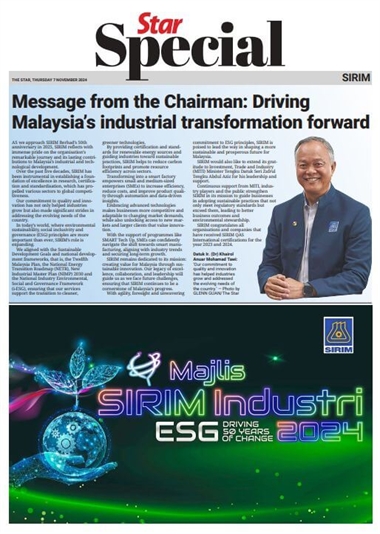
Datuk Ravindran Kurusamy
CARS – love ‘em, can’t live without ‘em, or complain about the sheer number of ‘em, Malaysia is undoubtedly a car-centric nation.
As of December 2023, Malaysia had over 36.3 million registered cars – impressive for a population of 35 million –even including “retired” cars.
Indeed, we have overtaken Thailand to become Asean’s second-largest car market, despite our northern neighbour having double the population and a road network 2.5 times longer.
Malaysia’s automotive ecosystem has come a long way. Since the first car was imported back in 1902 – a cutting-edge Mercedes Simplex – the landscape has grown from strength to strength.
From the first automobile assembly plant opened in 1926 by Ford Malaya – the first of its kind in South-East Asia, to the formalisation of the automotive industry in 1967, it has grown to encompass 27 vehicle producers and over 640 component manufacturers today.
All this progress notwithstanding, our well-established ecosystem is nevertheless built around internal combustion engine (ICE) vehicles at a time when the transition to greener automobiles is on the upswing.
In this, how will our dealerships, independent workshops, aftermarket parts and accessories companies, and others fare? Their fate can make an impact on our enthusiasm for adopting electric mobility.
Playing catch-up
Electric vehicles (EVs) first made an appearance in a small way in Malaysia in 1996 but did not catch on. Toyota and Honda introduced hybrid EVs in the early 2000s, giving Malaysians a taste of electrified mobility, but we still have a long way to go.
As of 2023, there were 16,763 registered EVs in Malaysia, out of around 40 million globally, although the number quickly increased to about 26,000 by the end of 2024. We may have been late to the game, but we are truly picking up the pace.
Today, drivers are spoilt for choice – a slew of new EV models have entered the market in recent years, mainly from Tesla, BYD and a host of other Chinese brands. Premium European brands like Porsche, BMW and Mercedes are also well represented in this segment.
Buyers are still mainly from the higher-income bracket, as import restrictions limit foreign cars to a RM100,000 minimum price. The encouragement for local brands to enter the market has seen early results. Proton’s recent e.MAS sport utility vehicle is making a great start, and is already a bestseller, with the upcoming Perodua EV set to further open up the market.
Tax breaks and other government incentives are expected to drive adoption, although with the options currently available, buyers are likely to comprise mainly mid to high-income earners
living in landed urban homes, using their EVs for shorter-range city driving.
Certainly, EVs are great for congested urban traffic, with zero tailpipe emissions being one of their strongest suits. However, with more than 80% of Malaysia’s grid energy coming from non-
renewable sources, the overall environmental benefit of EVs is dampened.
Accelerating adoption
Industry stakeholders, including the government, are working on reducing range anxiety. With just over 2,000 public EV chargers nationwide today, it’s a ratio of roughly eight EVs to a charger, which needs to improve significantly and rapidly to encourage greater uptake.
The demand for public charging is compounded by drivers lacking access to overnight charging infrastructure, due to limited charging points in high-rise residences. Creating change is certainly no mean feat, as our energy grid struggles with the power demand from EVs, especially from fast chargers.
Rapidly improving battery technology is helping, with safer systems and faster charging capability, but that can create other anxieties, as EV technology can rapidly become obsolete within a year or two compared to mature ICE technology.
Here, depreciation remains an obstacle for EV buyers. The EV transition may seem quick, but like ICE cars more than a century ago, EVs too need to overcome prejudices and establish stability, which may take years.
Driving the electric transition
Like other critical endeavours, the transition to EVs will not be easy. We need a minimum 5% market share for EVs to sustain adoption, and this means having sufficient charging infrastructure to support the targeted volume, and a pricing framework that makes cars, maintenance and parts, and resale values acceptable for the masses.
One must ask, can the market survive without special incentives, or at least, not more than what ICE vehicles enjoy?
Incentivising EVs whilst penalising ICE vehicles can be a short-term strategy to help establish presence, but is unsustainable in the longer term.
The choice is also not binary –hybrids are a good transitionary solution to greener mobility. They can achieve significant fuel savings compared to ICE cars while mitigating limitations in charging infrastructure, thus paving the way to a battery-powered EV-centric future.
As observed earlier, technology advancement can drive hesitancy despite also offering hope. Battery tech is advancing rapidly. Safer, more fire-resistant battery tech, like the BYD blade technology, is now in the market, addressing significant safety issues. Nickel-metal hydride battery (NiMH) is already obsolete, and lighter, solid-state batteries are just around the corner. However, with every new iteration, older tech becomes less valuable.
Future expectations
What picture does this paint for the market five or 10 years from now? With around 50,000 to 100,000 EVs running obsolete technology on our roads, will we still have the maintenance and parts ecosystem to support them? More significantly, what happens to all the ICE vehicles these EVs will replace? We still do not have a viable national automotive recycling strategy to manage these concerns.
Amidst global volatility, we are seeing many manufacturers, industries and governments slowing down or backtracking on their decarbonisation pledges. Policies are great but only when they can feasibly be put into action.
How will this affect our appetite for EVs in the coming years? Regardless of challenges, electric mobility is, no doubt, a strong means for decarbonisation. But effective implementation demands careful thought, planning and effort to resolve these pertinent questions in ways that benefit our nation in the long term.
The views expressed here are the writer’s own.










































